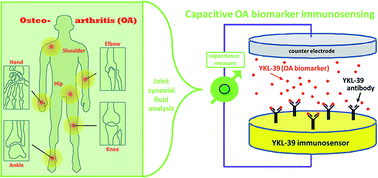A microfluidic capacitive immunosensor system for human cartilage chitinase-3-like protein 2 (hYKL-39) quantification as an osteoarthritis marker in synovial joint fluid†
Abstract
Worldwide, many people suffer from osteoarthritis, a painful condition that interferes with normal work and the enjoyment of life and is thus a serious personal and public problem. Good management of osteoarthritis requires methodologies for accurate and timely detection of disease onset, progression and response to treatment. Here, capacitive electrochemical immunosensors, using immobilized antibodies against the known osteoarthritis biomarker human cartilage chitinase-3-like protein 2, also known as hYKL-39, were used as novel tools for sensitive and selective osteoarthritis analysis. In the proposed procedure the current response of the sensor to a potential step application is measured; from the resultant traces, concentration-dependent capacitance changes, due to antigen binding, can be calculated. The linear range and detection limit of capacitive hYKL-39 immunosensing were respectively 0.1–1000 μg L−1 and 0.074 μg L−1. This was better than the characteristics of the enzyme-linked immunosorbent assay (ELISA) with an optical readout, which is presently the standard practice for laboratory hYKL-39 screening. In synovial fluid samples from osteoarthritis patients, capacitive hYKL-39 immunosensing reported the expected elevated hYKL-39 biomarker levels in quantitative agreement with ELISA analysis. The improved detection limit and linear range of the electrochemical hYKL-39 immunoassay combined with the potential of cheap, simple, miniaturizable, portable and automatable equipment recommend this novel approach as a promising complementary tool and ideal reference assay for osteoarthritis diagnosis and monitoring, in particular when the aim is early detection.


 Please wait while we load your content...
Please wait while we load your content...